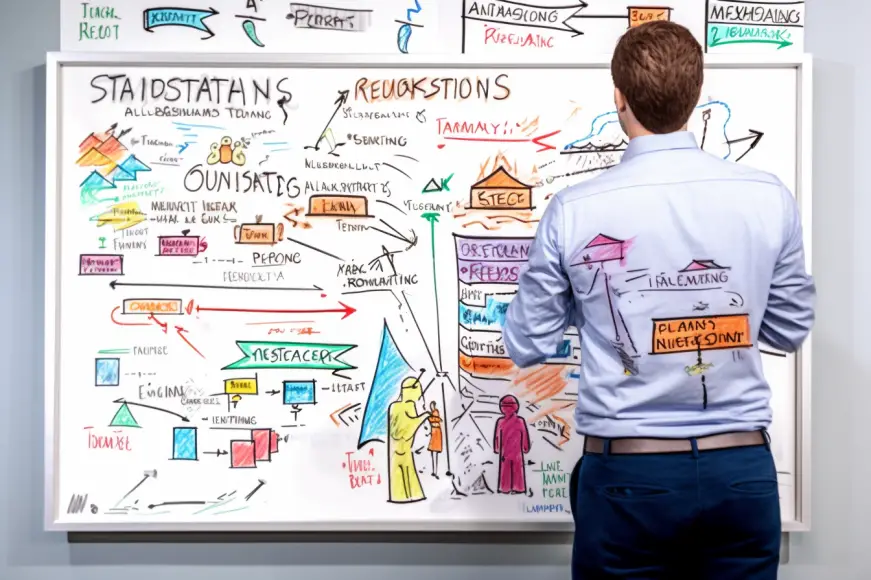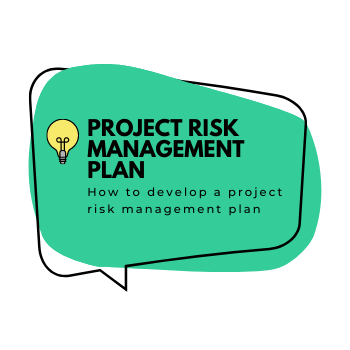Risk management is essential for any organization or individual seeking to minimize potential harm and maximize opportunities. A risk management plan identifies, assesses, prioritizes, and mitigates risks that may threaten achieving goals and objectives.
Creating a risk management plan involves identifying potential risks, assessing their impact, and developing strategies to manage them. Here’s a step-by-step guide on how to create a risk management plan:
Identify Potential Risks: The first step in creating a risk management plan is identifying risks. This can involve brainstorming sessions, consulting with team members, and reviewing past projects for common issues.
Risks can be associated with various aspects of the project, such as budget, timeline, resources, technology, and stakeholders.
Analyze Risks: Once you’ve identified potential risks, the next step is to analyze them. This involves determining the likelihood of each risk occurring and the potential impact on the project if it does. This can help you prioritize risks and focus on the ones that could have the greatest impact.
Plan Responses: For each risk, develop a strategy to manage it. This could involve avoiding the risk, mitigating it (reducing its impact or likelihood), transferring it (through insurance), or accepting the risk. Your response should be proportionate to the severity of the risk.
Assign Responsibility: Assign a person or team responsible for each risk. If necessary, this person or team will monitor the risk and implement the response plan.
Create a Contingency Plan: For each risk, create a contingency plan. This plan outlines the steps that will be taken if the risk occurs. A contingency plan can help you respond quickly and effectively if a risk becomes a reality.
Monitor and Review Risks: Risk management is an ongoing process. Regularly review your risk management plan to ensure it’s still relevant and effective. This should involve monitoring the identified risks, reassessing their impact and likelihood, and reviewing the effectiveness of your response plans.
Communicate: Ensure all relevant stakeholders know the risk management plan and understand their responsibilities. This can involve regular meetings or reports to keep everyone informed.
The first step is identifying potential risks by thoroughly analyzing internal and external factors impacting operations or projects. This includes analyzing historical data, consulting with stakeholders, reviewing industry trends and regulations, and considering environmental factors such as weather patterns or geopolitical events.
Once potential risks are identified, developing strategies for mitigating them is important. This involves prioritizing them based on their likelihood of occurrence and severity of impact. With this foundation set up correctly at the beginning stages of the planning process, creating an effective risk management plan becomes easier with continuous improvement efforts implemented along the way.
Implementing the plan, continuously evaluating its effectiveness, and seeking professional assistance are important steps in risk management.

Identify Potential Risks
The first step in developing a comprehensive risk management plan is identifying potential risks, which requires a systematic and thorough assessment of all possible threats that could harm the project or organization.
This process involves analyzing an organization or project’s internal and external environment to identify potential hazards, such as operational, financial, environmental, legal, and reputational risks.
To conduct this analysis effectively, it is important to involve stakeholders with a vested interest in the success of the project or organization.
Once potential risks have been identified, they should be categorized according to their likelihood and impact on the project or organization. This helps prioritize which risks need immediate attention and which can be monitored over time.
A common technique used for categorizing risks is called the probability-impact matrix. This tool allows organizations to assess each potential risk based on its likelihood of occurring and its impact if it does occur.
Finally, mitigation strategies should be developed after identifying and categorizing potential risks. Mitigation strategies are specific actions taken by an organization or project team to reduce the likelihood of a risk occurring or minimize its impact if it does occur.
These strategies can include contingency planning, insurance coverage, implementing additional controls or safeguards, and creating backup plans if something goes wrong.
It requires a systematic approach that analyzes internal and external factors that could threaten the organization or project. Once identified, these potential hazards can be categorized based on their likelihood and impact before mitigation strategies are developed for each one.
Develop Risk Mitigation Strategies
Developing effective strategies to mitigate potential risks is imperative for ensuring the success and sustainability of any project or venture. Risk mitigation involves identifying and assessing potential threats, determining their severity, and taking measures to prevent them.
It is a critical component of risk management that helps organizations avoid financial losses, reputational damage, legal liabilities, and other negative outcomes.
One key aspect of developing risk mitigation strategies is prioritizing risks based on their likelihood and potential impact. High-risk areas require immediate attention and action, while low-risk areas can be addressed later. Once the risks have been prioritized, specific actions can be taken to address each one.
For example, if a particular risk could result in significant financial losses, steps should be taken to reduce exposure by diversifying investments or purchasing insurance.
Continuous monitoring and evaluation is another critical element of developing effective risk mitigation strategies. Risk factors are constantly changing, so it’s important to regularly assess the progress made toward mitigating identified risks and adjust plans as necessary.
This means having clear metrics for measuring risk reduction efforts, such as increased security measures or improved employee training programs. In conclusion, developing effective strategies for mitigating potential risks requires careful planning and execution.
Prioritizing risks based on likelihood and severity enables organizations to focus on high-impact areas first, while continuous monitoring ensures that plans remain relevant over time.
Successful risk mitigation ensures that projects are completed within budget constraints while minimizing negative consequences like reputational damage or legal liabilities.
Implement a Risk Management Plan
Effective implementation of a comprehensive strategy for mitigating potential risks is crucial to ensure any project or venture’s long-term success and sustainability. Once risk mitigation strategies have been identified, it is time to implement the plan. Implementation requires careful planning, communication, monitoring, and evaluation.
One effective way to implement a risk management plan is through a table that outlines the specific actions required at each stage of the project. The table should include four columns: Risk Category, Action Required, Responsible Party, and Deadline.
In the first column, risks are categorized based on their severity and likelihood of occurring. The second column details what needs to be done in response to each risk category. In the third column, responsible parties are identified for each action item. Finally, deadlines are established for the completion of each task.
Once the table has been created and all necessary stakeholders have been informed about their roles and responsibilities, it is important to monitor progress regularly.
Regular check-ins can help identify issues before they become significant problems and allow for adjustments as needed. Evaluation of critical junctures throughout the project can also help ensure that risks continue to be mitigated effectively.
Risk management plan implementation requires clear communication with all stakeholders involved in a project or venture by creating an actionable table that outlines specific tasks required at each stage of development, identifying responsible parties, and establishing deadlines for completion.
One can significantly mitigate potential risks by staying proactive throughout various stages, such as the planning and execution phases. Thereby ensuring long-term success and sustainability while minimizing negative impact from unforeseen events or circumstances arising during those phases within said projects or ventures.
Continuously Evaluate and Improve the Plan
It is important to track and analyze risk incidents to identify trends and potential areas for improvement.
Additionally, the plan should be reviewed and updated as necessary based on new information or changes in the environment.
Finally, incorporating stakeholder feedback can provide valuable insights into how the plan can be improved to meet their needs better.
Track and Analyze Risk Incidents
Tracking and analyzing risk incidents is a crucial step in the risk management process, as it enables organizations to identify patterns, assess the severity of risks, and develop strategies to mitigate potential harm.
By keeping records of all incidents related to risks within an organization, businesses can gain valuable insights into the types of risks that threaten their operations. This information can then be used to establish preventative measures and avoid future occurrences.
Moreover, tracking and analyzing risk incidents allows organizations to assess the effectiveness of their current risk management plan. By reviewing incident reports regularly, organizations can determine which policies or procedures require modification or improvement.
Additionally, consistent tracking and analysis provide insight into how well employees adhere to safety protocols or training programs. Organizations may use this information to fine-tune their training program or revise existing safety procedures for better compliance with regulations or industry standards.
Tracking and analyzing risk incidents offer invaluable data for improving organizational processes while reducing exposure to potential hazards.
Review and Update the Plan as Needed
To ensure continued success in risk mitigation, it is essential for organizations to regularly review and update their risk management strategies based on new information and changing circumstances.
A static risk management plan may no longer be effective if the organization’s environment has evolved or if there have been changes in regulations or industry standards. Regularly reviewing the plan helps organizations identify gaps, weaknesses, and opportunities for improvement.
When reviewing the plan, organizations should consider factors such as:
- Changes in their business model
- Emerging risks that were not previously identified
- The effectiveness of existing mitigation measures
Updating the plan may involve modifying existing or new processes to address identified gaps. It is also important to communicate any changes made to all organizational stakeholders so that they know what is expected of them going forward.
Conducting regular reviews and updates of their risk management plans, organizations can maintain a proactive approach toward mitigating risks while adapting to changing circumstances.
Incorporate Feedback from Stakeholders
To ensure the effectiveness of a risk management plan, it is important to review and update it regularly as needed. This process involves identifying new risks that may have emerged since the last review, evaluating existing risk mitigation measures, and making adjustments where necessary.
However, an equally important step in this process is incorporating stakeholder feedback.
Stakeholders can provide valuable insights into an organization’s potential risks and how they may impact different aspects of its operations. Therefore, organizations must seek input when reviewing and updating their risk management plans.
This could involve consulting with employees at all levels of the organization, external partners or customers, regulatory bodies, or industry associations. By gathering feedback from these various sources, organizations can get a more comprehensive picture of their risks and develop more effective strategies for mitigating them.
Additionally, involving stakeholders in this process can help build trust and confidence in an organization’s risk management approach.
Seek Professional Assistance if Needed
Professional assistance may be sought in developing a risk management plan to ensure its effectiveness and accuracy. Risk management plans require understanding complex concepts such as statistical analysis, probability theory, and scenario planning; thus, seeking professional help can provide essential expertise in these areas.
Moreover, hiring professionals can reduce the time and effort required to develop a comprehensive risk management plan.
The benefits of seeking professional assistance go beyond technical expertise. Professional consultants often bring fresh perspectives and insights that internal teams may lack due to their familiarity with the organization’s culture and processes.
Additionally, working with external experts can help organizations identify blind spots or weaknesses in their existing risk management strategies.
However, before engaging any consultant or service provider to develop a risk management plan, evaluating their qualifications and experience is crucial. Organizations should consider factors such as the consultant’s track record, reputation within the industry, relevant certifications or licenses, and references from previous clients.

Frequently Asked Questions
What are the common mistakes businesses make when creating a risk management plan?
Common mistakes businesses make when creating a risk management plan include inadequate identification and assessment of risks, insufficient allocation of resources, failure to review and update the plan regularly, and lack of employee engagement in the process.
How do you prioritize risks and determine which ones to address first?
A risk assessment matrix can be used to prioritize risks and determine which ones to address first. This tool evaluates the likelihood and impact of each risk, allowing businesses to focus on high-priority risks that have severe consequences if left unaddressed.
What types of insurance policies can help mitigate risks?
Various insurance policies can help mitigate risks. For instance, property insurance protects against damage or loss of physical assets, while liability insurance covers legal claims arising from injuries or damages caused by the insured party.
How do you communicate the risk management plan to stakeholders and employees?
To communicate a risk management plan to stakeholders and employees, providing clear and concise information about the identified risks, potential impacts, mitigation strategies, and contingency plans is important.
Regular updates should be provided to ensure that everyone is informed about any changes or new risks that may arise.
How often should the risk management plan be updated and reviewed?
The risk management plan should be reviewed and updated regularly, depending on the nature of the risks involved. This can range from quarterly to annually or as needed to ensure that it effectively mitigates risks and protects the organization.

Conclusion
In conclusion, developing a risk management plan is crucial for any organization to ensure its long-term success. The first step in creating such a plan involves identifying potential risks the organization may face.
Once these risks are identified, developing strategies to mitigate them effectively is essential. The next step is implementing the risk management plan and monitoring its effectiveness continuously.
Reviewing and updating the plan regularly is vital, considering changes in the organization’s environment and business landscape. Seeking professional assistance can also be beneficial in creating an effective risk management plan.
A well-designed risk management plan can help organizations achieve their objectives while safeguarding their reputation and financial stability against unforeseen events or circumstances.

Chris Ekai is a Risk Management expert with over 10 years of experience in the field. He has a Master’s(MSc) degree in Risk Management from University of Portsmouth and is a CPA and Finance professional. He currently works as a Content Manager at Risk Publishing, writing about Enterprise Risk Management, Business Continuity Management and Project Management.


